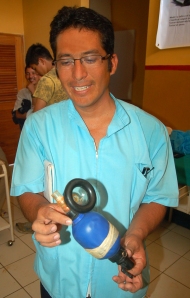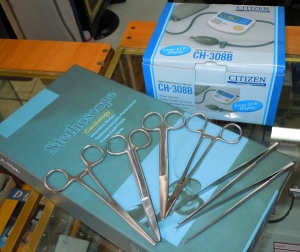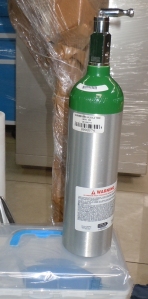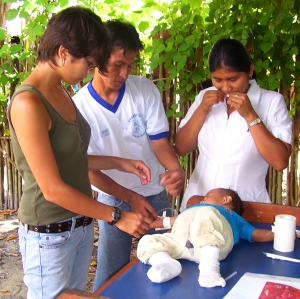By Campbell Plowden
CACE’s relationship with the public health clinic in Jenaro Herrera began when my daughter Marissa Plowden volunteered there in the summers of 2006 and 2007. Since 2008, CACE has used part of its social rebate from the sale of handicrafts made by artisans from Jenaro to buy supplies for the clinic that serves this town of 5000 people and a dozen other campesino communities along the Ucayali River. These clinics are vitally important to the residents of these remote areas for basic health care and simple emergencies – like treating snake bites.
CACE delivering donated medical supplies to Jenaro Herrera clinic. Photo by Campbell Plowden/Center for Amazon Community Ecology

Old resuscitator at Jenaro Herrera clinic. Photo by Campbell Plowden/Center for Amazon Community Ecology

Forceps in Jenaro Herrera delivery room. Photo by Campbell Plowden/Center for Amazon Community Ecology
The clinic’s intern doctor, Sainet Serna, showed us to the maternity room – the busiest place in the clinic where one young mother had recently given birth. It was equipped with one adjustable bed, five worn forceps, an adult size resuscitator patched together with duct tape, and one broken lamp. When I told Sainet about our social rebate, she and two technicians gave me a wish list for the simple items that could make their operation more functional.
While we could have bought some of these supplies in Iquitos, Sainet assured us we could get most of these much cheaper in Lima. Three weeks later, Luke and I made our way to a section of Avenida Emancipacion in downtown Lima that is lined with stores selling nothing but medical and lab equipment.

New forceps and blood pressure cuff for Jenaro Herrera clinic. Photo by Campbell Plowden/Center for Amazon Community Ecology
We wandered into a mini-mall, did some comparison shopping and were very pleased that we were able to buy everything on the Jenaro Herrera wish list (except one item’s description no one could understood) for $326 – just under what we had available from the 20% rebate of craft sales from the Jenaro artisans. So thank you to everyone who bought woven chambira butterflies, stars and other kinds of holiday tree ornaments from CACE in the past year. Thanks also to Trent Chalker, a world traveler we stayed with at the Pariwana backpackers hostel who contributed another $11 to help pay for these supplies.

Luke Plowden with new stethoscope for Jenaro Herrera clinic. Photo by Campbell Plowden/Center for Amazon Community Ecology
Our purchases included 4 Kocher forceps, 2 Mayo curved scissors, 2 dissection forceps with tips, 4 Kelly forceps, 2 blood pressure cuffs, a pediatric stethoscope, a pediatric resuscitator, a goose neck lamp, and a portable oxygen tank with a manometer. We boxed up the gear and brought it to an international courier to send off to Jenaro.

Portable oxygen tank for Jenaro Herrera clinic. Photo by Campbell Plowden/Center for Amazon Community Ecology
We hit one road block when they would not take the oxygen tank for the flight to Iquitos even though it was empty. We also struck out finding any other service willing to do the delivery. I began to realize why the Jenaro clinic had been stuck without a functioning tank for years. I arranged to leave the tank with a friend in Lima to send to Jenaro via bus and boat. I was at least relieved to get an email of thanks from Sainet that all the other supplies safely arrived.



